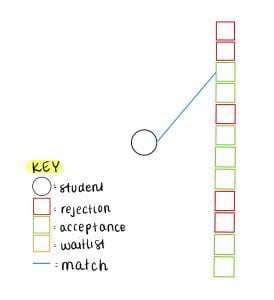The matching game getting students into college
Started in 2004, the QuestBridge college matching program has been hailed for its mission to help low-income students gain admission to some of the most prestigious schools in the nation and/or the world. Offering a full 4-year tuition to the list of partner colleges including names like Stanford, MIT, and five out of the eight Ivy League universities, it’s no wonder the program received over 16,500 applications during the most recent application cycle. But how does this program work?
According to the QuestBridge website, matches occur in two phases: first, applicants submit a general application to the QuestBridge program. These applications are reviewed by QuestBridge, who selects a set of Finalists. After this phase, applicants are either classified as Finalists or Non-Finalists. From here, Non-Finalists must apply through regular college application systems such as CommonApp. On the other hand, Finalists are invited to apply to partner schools, ranking 12 of the 48 QuestBridge partner schools based on interest and fit. Colleges then review the profiles and applications of students who included the college in their ranked list and return a list of applicants they would like to accept via the Match program. A match occurs between a student and the highest college on their list that accepted them and results in binding admission to the school. If a student is rejected from all of these schools, they can apply Early Action, Early Decision, or Regular Decision to more schools via the Questbridge portal.
As can be inferred both from the nature of the program and its name, this process uses a matching algorithm akin to those studied in this class to form matches between applicants and schools. For example, in the diagram below, we see that the student was rejected from 5 colleges and accepted at 7. Since their third-choice university is the highest-ranked college they were accepted at, they match with that school and will attend university there in the fall.

This system provides an interesting example of a modified first-price auction wherein the colleges and students both serve as the auctioneers and buyers. The student places numerically ranked bids on the institutions and the college or university while the university places yes/no bids on students. Conversely, the student “auctions themself off” and “sells” to the highest-ranked university while the university “auctions off acceptances” and “sells” to the students who they would like to accept. As buyers, the best response of students is to rank the colleges truthfully in terms of their desire to attend so that, if matched, they will attend a school they genuinely want to go to; the best response of universities to only accept students they would want at their institution so that they only have attendees whom they like and who also like them.
The Questbridge Match System is a unique matching market that, unlike others we study in this course, uses a dual-role system to create successful pairings that aims to provide satisfaction to both parties.
